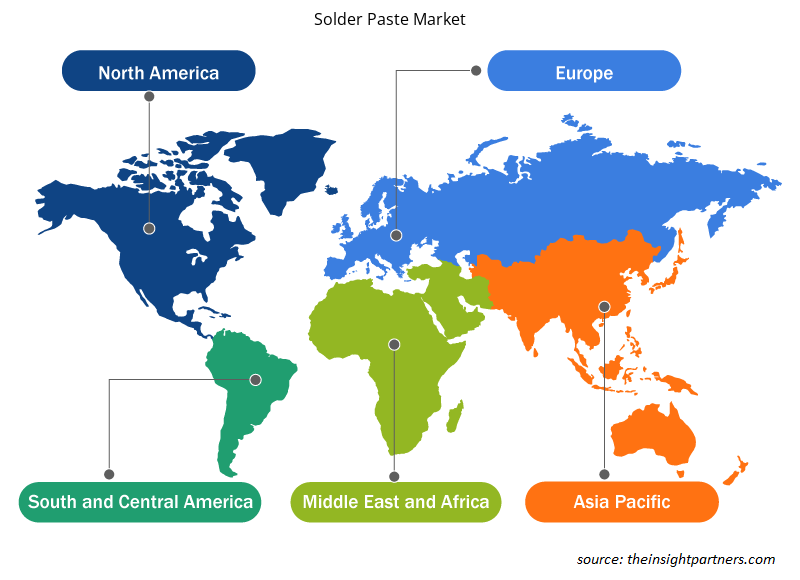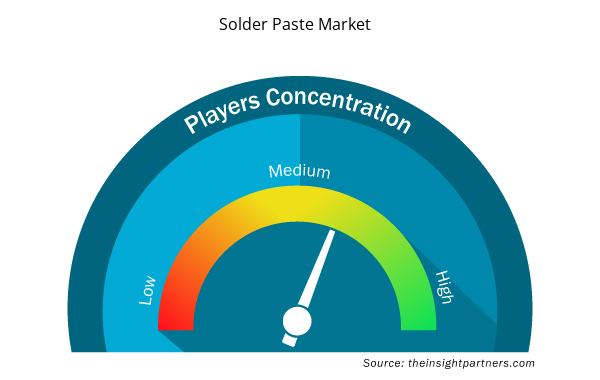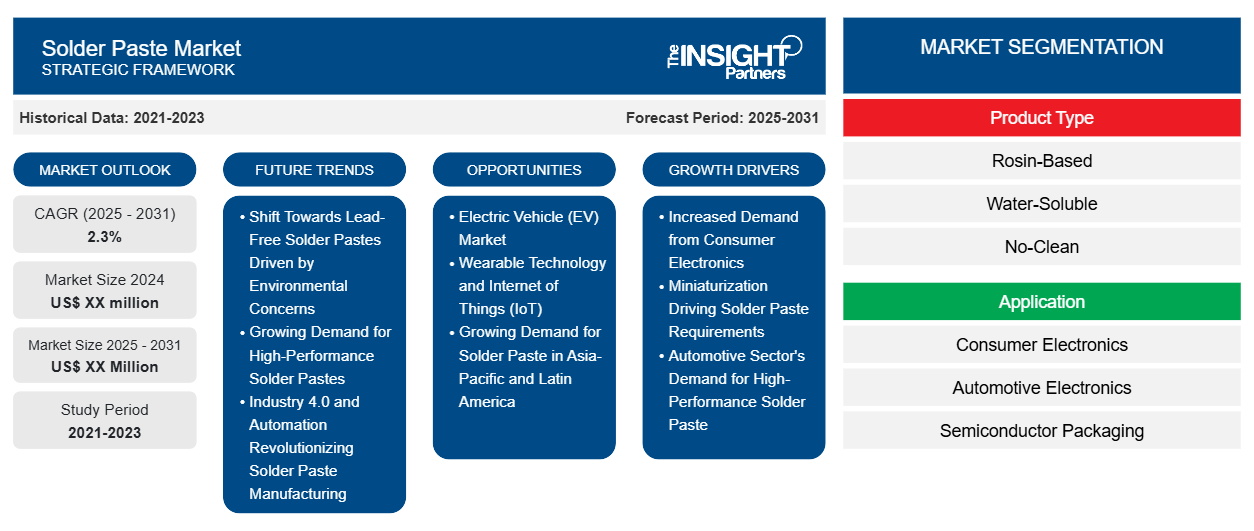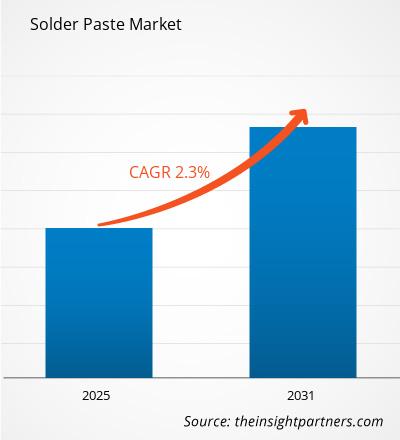Se espera que el mercado de pasta de soldadura registre una CAGR del 2,3% entre 2024 y 2031, con un tamaño de mercado que se expandirá de US$ XX millones en 2024 a US$ XX millones en 2031.
El informe está segmentado por tipo de producto (basado en colofonia, soluble en agua y sin limpieza). El informe presenta además un análisis basado en la aplicación (electrónica de consumo, electrónica automotriz, empaquetado de semiconductores y otros). El alcance del informe cubre cinco regiones: América del Norte, Europa, Asia Pacífico, Medio Oriente y África, y América del Sur y Central y los países clave de cada región. El análisis global se desglosa aún más a nivel regional y por países principales. El informe ofrece el valor en USD para el análisis y los segmentos anteriores.
Propósito del Informe
El informe Solder Paste Market de The Insight Partners tiene como objetivo describir el panorama actual y el crecimiento futuro, los principales factores impulsores, los desafíos y las oportunidades. Esto proporcionará información a diversas partes interesadas del negocio, como:
- Proveedores/fabricantes de tecnología: Para comprender la dinámica cambiante del mercado y conocer las oportunidades potenciales de crecimiento, lo que les permitirá tomar decisiones estratégicas informadas.
- Inversionistas: Realizar un análisis exhaustivo de tendencias sobre la tasa de crecimiento del mercado, las proyecciones financieras del mercado y las oportunidades que existen en toda la cadena de valor.
- Órganos reguladores: Regular las políticas y vigilar las actividades del mercado con el objetivo de minimizar los abusos, preservar la confianza de los inversores y defender la integridad y la estabilidad del mercado.
Segmentación del mercado de pasta de soldadura
Tipo de producto
- A base de colofonia
- Soluble en agua
- Sin limpieza
Solicitud
- Electrónica de consumo
- Electrónica automotriz
- Envasado de semiconductores
Personalice este informe según sus necesidades
Obtendrá personalización en cualquier informe, sin cargo, incluidas partes de este informe o análisis a nivel de país, paquete de datos de Excel, así como también grandes ofertas y descuentos para empresas emergentes y universidades.
- Obtenga las principales tendencias clave del mercado de este informe.Esta muestra GRATUITA incluirá análisis de datos, desde tendencias del mercado hasta estimaciones y pronósticos.
Factores impulsores del crecimiento del mercado de pasta de soldadura
- Aumento de la demanda de productos electrónicos de consumo: el aumento de la demanda de productos electrónicos de consumo, incluidos teléfonos inteligentes, computadoras portátiles y dispositivos portátiles, junto con otros dispositivos inteligentes, es el principal factor impulsor del mercado de pasta de soldadura. La pasta de soldadura es un material esencial en la tecnología de montaje superficial (SMT) para ensamblar estos dispositivos. Una industria de semiconductores en resurgimiento alimenta aún más la demanda al depender de la pasta de soldadura para un ensamblaje eficiente y confiable de chips y otros componentes. A medida que los productos electrónicos de consumo se vuelven más pequeños y compactos con tecnologías más avanzadas, aumenta la demanda de pasta de soldadura de alta calidad para aumentar la precisión y la confiabilidad en la colocación de los componentes.
- La miniaturización impulsa los requisitos de la pasta de soldadura: la miniaturización en la industria electrónica es otra tendencia crítica que impulsa el mercado de la pasta de soldadura. A medida que los dispositivos de silicio se vuelven más pequeños y con mayores capacidades, los fabricantes deben tener pasta de soldadura con un tamaño de partícula más fino y propiedades superiores para ensamblar unidades pequeñas y eficientes para sus componentes. Lo mismo se aplica a una gran cantidad de teléfonos inteligentes, dispositivos portátiles y productos de IoT que requieren componentes miniaturizados. La pasta de soldadura, con una composición finamente ajustada, desempeña un papel fundamental en las interconexiones de alta densidad para dispositivos y placas de circuitos más pequeños.
- Demanda de pasta de soldadura de alto rendimiento en el sector de la automoción: los factores que impulsan el sector de la automoción incluyen la complejidad y la creciente dependencia de la electrónica a través de los vehículos eléctricos, la conducción autónoma y los sistemas avanzados de asistencia al conductor; por lo tanto, la demanda de pasta de soldadura está aumentando. La electrónica automotriz requiere uniones de soldadura de alta confiabilidad y larga duración para aplicaciones críticas como sensores, unidades de control y electrónica de potencia. El mayor contenido de electrónica en los vehículos modernos, especialmente en los vehículos eléctricos e híbridos, continúa aumentando la necesidad de pastas de soldadura de alta temperatura, capaces de soportar tales condiciones durante períodos prolongados, un factor clave del crecimiento del mercado.
Tendencias futuras del mercado de pasta de soldadura
- El cambio hacia las pastas de soldadura sin plomo está impulsado por preocupaciones medioambientales: las preocupaciones medioambientales y la presión regulatoria de la directiva RoHS (Restricción de Sustancias Peligrosas) de la Unión Europea han hecho que la industria se aleje significativamente de las pastas de soldadura a base de plomo y la obligue a sustituirlas por tipos sin plomo. Las pastas de soldadura sin plomo, principalmente basadas en aleaciones como estaño-plata-cobre (SAC), se están convirtiendo progresivamente en un nuevo estándar en la fabricación de productos electrónicos. El cumplimiento de las regulaciones medioambientales y una creciente atención a la sostenibilidad impulsan esta tendencia. Las pastas de soldadura sin plomo también tienen ventajas como un mejor rendimiento bajo ciclos térmicos junto con una mayor resistencia mecánica, por lo que son adecuadas para una amplia gama de aplicaciones electrónicas.
- Demanda creciente de pastas de soldadura de alto rendimiento: con una complejidad tan alta en los dispositivos electrónicos, existe una demanda creciente de pastas de soldadura de alto rendimiento con características superiores, como capacidades de paso alto, alta estabilidad térmica y tiempos de reflujo rápidos. Ahora es cuando se desean pastas de soldadura de mayor calidad donde la confiabilidad se pueda colocar en una aplicación de componentes de paso más fino en la electrónica más pequeña y sofisticada con aplicaciones en teléfonos inteligentes, dispositivos médicos y electrónica automotriz. Estos requisitos impulsan la innovación en las formulaciones de pasta de soldadura: excelente humectación, baja formación de huecos y buena actividad de fundente.
- La Industria 4.0 y la automatización revolucionan la fabricación de pasta de soldadura: los principios de la Industria 4.0, junto con el mayor uso de la automatización en las líneas de producción de tecnología de montaje superficial (SMT), están definiendo el mercado de la pasta de soldadura. La impresión automatizada de pasta de soldadura, junto con sistemas de control de calidad mejorados, permite una mayor precisión, menos defectos y una aplicación uniforme de la pasta de soldadura. Esto, a su vez, ayudará a los fabricantes a optimizar sus procesos de producción, aumentar la productividad y reducir los costos. Los sensores y los sistemas de monitoreo en tiempo real integrados en las líneas SMT hacen que las aplicaciones de pasta de soldadura sean más precisas. En la fabricación de alto volumen, se mejora la tasa de rendimiento y se reducen los desechos.
Oportunidades de mercado de pasta de soldadura
- Mercado de vehículos eléctricos (VE): una oportunidad de crecimiento clave para el mercado de pasta de soldadura: el auge de los vehículos eléctricos es una gran oportunidad para el mercado de pasta de soldadura. La adopción generalizada de vehículos eléctricos está aumentando la demanda de componentes electrónicos que deben ser robustos y de alto rendimiento dentro del sector automotriz. Los VE han utilizado una gran cantidad de sistemas electrónicos para la gestión de baterías, electrónica de potencia, inversores, sensores y funciones ADAS que requieren uniones de soldadura eficientes y altamente confiables. Esto permite a los fabricantes de pasta de soldadura aprovechar aplicaciones de alta confiabilidad y sensibles a la temperatura dentro de la electrónica automotriz.
- Tecnología portátil e Internet de las cosas (IoT): mercado emergente para la pasta de soldadura: los avances en la tecnología portátil y el crecimiento del mercado de Internet de las cosas están brindando oportunidades potenciales para el mercado de la pasta de soldadura. Los dispositivos portátiles (relojes inteligentes, rastreadores de actividad y dispositivos portátiles biológicos) necesitan componentes electrónicos pequeños y confiables y, por lo tanto, pasta de soldadura de alto rendimiento para ensamblarlos. En la misma línea, con el aumento en la proliferación de dispositivos IoT y la complejidad de su tamaño, también ha aumentado la demanda de pastas de soldadura que puedan ayudar fácilmente a soportar componentes más miniaturizados en diseños muy compactos y energéticamente eficientes. Los mercados están surgiendo y forman un área de crecimiento masivo para los fabricantes de pasta de soldadura.
- Demanda creciente de pasta de soldadura en Asia-Pacífico y América Latina: La demanda de pasta de soldadura en Asia-Pacífico y América Latina está creciendo rápidamente. Es probable que la demanda de pasta de soldadura aumente en China, India, Corea del Sur y Brasil, especialmente porque estos países están experimentando un rápido crecimiento en la tendencia de fabricación de productos electrónicos, que también se ve impulsada por una mayor demanda interna y la expansión de las industrias de semiconductores y automotriz. El crecimiento de los servicios de fabricación de productos electrónicos y la fabricación de productos electrónicos por contrato en estas regiones ofrece un enorme alcance para la expansión de los proveedores de pasta de soldadura. Los fabricantes pueden captar este mercado proporcionando pastas de soldadura de alta calidad y bajo costo que cumplan con los requisitos de las industrias locales y un comienzo hacia el cumplimiento de las normas internacionales.
Perspectivas regionales del mercado de pasta de soldadura
Los analistas de Insight Partners explicaron en detalle las tendencias y los factores regionales que influyen en el mercado de pasta de soldadura durante el período de pronóstico. Esta sección también analiza los segmentos y la geografía del mercado de pasta de soldadura en América del Norte, Europa, Asia Pacífico, Oriente Medio y África, y América del Sur y Central.

- Obtenga datos regionales específicos para el mercado de pasta de soldadura
Alcance del informe de mercado de pasta de soldadura
| Atributo del informe | Detalles |
|---|---|
| Tamaño del mercado en 2024 | XX millones de dólares estadounidenses |
| Tamaño del mercado en 2031 | US$ XX millones |
| CAGR global (2025 - 2031) | 2,3% |
| Datos históricos | 2021-2023 |
| Período de pronóstico | 2025-2031 |
| Segmentos cubiertos | Por tipo de producto
|
| Regiones y países cubiertos | América del norte
|
| Líderes del mercado y perfiles de empresas clave |
|
Densidad de actores del mercado de pasta de soldadura: comprensión de su impacto en la dinámica empresarial
El mercado de pasta de soldadura está creciendo rápidamente, impulsado por la creciente demanda de los usuarios finales debido a factores como la evolución de las preferencias de los consumidores, los avances tecnológicos y una mayor conciencia de los beneficios del producto. A medida que aumenta la demanda, las empresas amplían sus ofertas, innovan para satisfacer las necesidades de los consumidores y aprovechan las tendencias emergentes, lo que impulsa aún más el crecimiento del mercado.
La densidad de actores del mercado se refiere a la distribución de las empresas o firmas que operan dentro de un mercado o industria en particular. Indica cuántos competidores (actores del mercado) están presentes en un espacio de mercado determinado en relación con su tamaño o valor total de mercado.
Las principales empresas que operan en el mercado de pasta de soldadura son:
- AIM Metales y Aleaciones LP
- Corporación Henkel
- Corporación Indio
- Inventec
- Kester
Descargo de responsabilidad : Las empresas enumeradas anteriormente no están clasificadas en ningún orden particular.

- Obtenga una descripción general de los principales actores clave del mercado de pasta de soldadura
Puntos de venta clave
- Cobertura integral: el informe cubre de manera integral el análisis de productos, servicios, tipos y usuarios finales del mercado de pasta de soldadura, proporcionando un panorama holístico.
- Análisis de expertos: el informe se compila sobre la base de un profundo conocimiento de expertos y analistas de la industria.
- Información actualizada: El informe asegura relevancia comercial debido a su cobertura de información reciente y tendencias de datos.
- Opciones de personalización: este informe se puede personalizar para satisfacer los requisitos específicos del cliente y adaptarse adecuadamente a las estrategias comerciales.
Por lo tanto, el informe de investigación sobre el mercado de pasta de soldadura puede ayudar a abrir camino para descifrar y comprender el escenario de la industria y las perspectivas de crecimiento. Si bien puede haber algunas preocupaciones válidas, los beneficios generales de este informe tienden a superar las desventajas.
- Análisis histórico (2 años), año base, pronóstico (7 años) con CAGR
- Análisis PEST y FODA
- Tamaño del mercado Valor/volumen: global, regional, nacional
- Industria y panorama competitivo
- Conjunto de datos de Excel



Report Coverage
Revenue forecast, Company Analysis, Industry landscape, Growth factors, and Trends

Segment Covered
This text is related
to segments covered.

Regional Scope
North America, Europe, Asia Pacific, Middle East & Africa, South & Central America

Country Scope
This text is related
to country scope.
Preguntas frecuentes
Increased demand for high-performance solder pastes is expected to be the key market trend.
The report can be delivered in PDF/Word format, we can also share excel data sheet based on request.
On the basis of geography, the solder paste market is classified into North America, Europe, Asia Pacific, Middle East and Africa, and South and Central America
AIM Metals and Alloys LP, Asahi Solder, DJK Europe GmbH, Fusion Inc, GENMA Europe GmbH, Henkel Corp, Indium Corp, Kester Inc, MacDermid Alpha Electronics Solutions, and Tamura Corp
The major factors driving the solder paste market are:
1. Growth in Consumer Electronics and Semiconductor Industries.
2. Miniaturization of Electronic Components.
The Solder Paste Market is estimated to witness a CAGR of 2.3% from 2023 to 2031
Trends and growth analysis reports related to Chemicals and Materials : READ MORE..
The List of Companies
- AIM Metals & Alloys LP
- Henkel Corporation
- Indium Corporation
- Inventec
- Kester
- KOKI Company Ltd.
- MacDermid Alpha Electronics Solutions
- Nihon Superior Co., Ltd.
- Senju Metal Industry Co., Ltd.
- TAMURA Corporation
The Insight Partners performs research in 4 major stages: Data Collection & Secondary Research, Primary Research, Data Analysis and Data Triangulation & Final Review.
- Data Collection and Secondary Research:
As a market research and consulting firm operating from a decade, we have published and advised several client across the globe. First step for any study will start with an assessment of currently available data and insights from existing reports. Further, historical and current market information is collected from Investor Presentations, Annual Reports, SEC Filings, etc., and other information related to company’s performance and market positioning are gathered from Paid Databases (Factiva, Hoovers, and Reuters) and various other publications available in public domain.
Several associations trade associates, technical forums, institutes, societies and organization are accessed to gain technical as well as market related insights through their publications such as research papers, blogs and press releases related to the studies are referred to get cues about the market. Further, white papers, journals, magazines, and other news articles published in last 3 years are scrutinized and analyzed to understand the current market trends.
- Primary Research:
The primarily interview analysis comprise of data obtained from industry participants interview and answers to survey questions gathered by in-house primary team.
For primary research, interviews are conducted with industry experts/CEOs/Marketing Managers/VPs/Subject Matter Experts from both demand and supply side to get a 360-degree view of the market. The primary team conducts several interviews based on the complexity of the markets to understand the various market trends and dynamics which makes research more credible and precise.
A typical research interview fulfils the following functions:
- Provides first-hand information on the market size, market trends, growth trends, competitive landscape, and outlook
- Validates and strengthens in-house secondary research findings
- Develops the analysis team’s expertise and market understanding
Primary research involves email interactions and telephone interviews for each market, category, segment, and sub-segment across geographies. The participants who typically take part in such a process include, but are not limited to:
- Industry participants: VPs, business development managers, market intelligence managers and national sales managers
- Outside experts: Valuation experts, research analysts and key opinion leaders specializing in the electronics and semiconductor industry.
Below is the breakup of our primary respondents by company, designation, and region:

Once we receive the confirmation from primary research sources or primary respondents, we finalize the base year market estimation and forecast the data as per the macroeconomic and microeconomic factors assessed during data collection.
- Data Analysis:
Once data is validated through both secondary as well as primary respondents, we finalize the market estimations by hypothesis formulation and factor analysis at regional and country level.
- Macro-Economic Factor Analysis:
We analyse macroeconomic indicators such the gross domestic product (GDP), increase in the demand for goods and services across industries, technological advancement, regional economic growth, governmental policies, the influence of COVID-19, PEST analysis, and other aspects. This analysis aids in setting benchmarks for various nations/regions and approximating market splits. Additionally, the general trend of the aforementioned components aid in determining the market's development possibilities.
- Country Level Data:
Various factors that are especially aligned to the country are taken into account to determine the market size for a certain area and country, including the presence of vendors, such as headquarters and offices, the country's GDP, demand patterns, and industry growth. To comprehend the market dynamics for the nation, a number of growth variables, inhibitors, application areas, and current market trends are researched. The aforementioned elements aid in determining the country's overall market's growth potential.
- Company Profile:
The “Table of Contents” is formulated by listing and analyzing more than 25 - 30 companies operating in the market ecosystem across geographies. However, we profile only 10 companies as a standard practice in our syndicate reports. These 10 companies comprise leading, emerging, and regional players. Nonetheless, our analysis is not restricted to the 10 listed companies, we also analyze other companies present in the market to develop a holistic view and understand the prevailing trends. The “Company Profiles” section in the report covers key facts, business description, products & services, financial information, SWOT analysis, and key developments. The financial information presented is extracted from the annual reports and official documents of the publicly listed companies. Upon collecting the information for the sections of respective companies, we verify them via various primary sources and then compile the data in respective company profiles. The company level information helps us in deriving the base number as well as in forecasting the market size.
- Developing Base Number:
Aggregation of sales statistics (2020-2022) and macro-economic factor, and other secondary and primary research insights are utilized to arrive at base number and related market shares for 2022. The data gaps are identified in this step and relevant market data is analyzed, collected from paid primary interviews or databases. On finalizing the base year market size, forecasts are developed on the basis of macro-economic, industry and market growth factors and company level analysis.
- Data Triangulation and Final Review:
The market findings and base year market size calculations are validated from supply as well as demand side. Demand side validations are based on macro-economic factor analysis and benchmarks for respective regions and countries. In case of supply side validations, revenues of major companies are estimated (in case not available) based on industry benchmark, approximate number of employees, product portfolio, and primary interviews revenues are gathered. Further revenue from target product/service segment is assessed to avoid overshooting of market statistics. In case of heavy deviations between supply and demand side values, all thes steps are repeated to achieve synchronization.
We follow an iterative model, wherein we share our research findings with Subject Matter Experts (SME’s) and Key Opinion Leaders (KOLs) until consensus view of the market is not formulated – this model negates any drastic deviation in the opinions of experts. Only validated and universally acceptable research findings are quoted in our reports.
We have important check points that we use to validate our research findings – which we call – data triangulation, where we validate the information, we generate from secondary sources with primary interviews and then we re-validate with our internal data bases and Subject matter experts. This comprehensive model enables us to deliver high quality, reliable data in shortest possible time.


 Obtenga una muestra gratuita de este informe
Obtenga una muestra gratuita de este informe